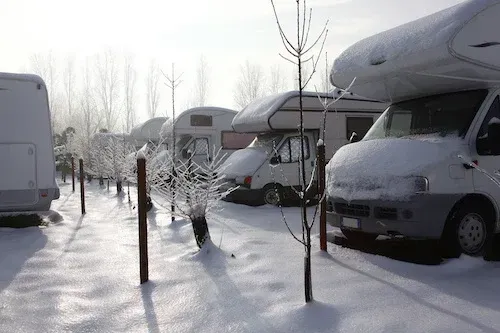RV Winter Storage Tips: How to Protect Your Vehicle During the Off-Season

1. Start with Thorough Cleaning and Inspection
Before you store your RV for the winter, it’s important to clean and inspect every part of your vehicle. This ensures you catch any potential issues and minimizes the risk of damage during RV winter storage.
- Exterior Cleaning: Wash and wax the exterior to protect against dirt and grime that can erode the paint over time. A wax coat adds a layer of protection against moisture.
- Interior Cleaning: Remove all food, empty trash cans, and thoroughly clean the interior to prevent odors and pest infestations.
- Inspect Seals and Joints: Check seals around windows, doors, and slide-outs for any cracks or wear. Apply sealant if needed to keep moisture out.
By starting with a clean slate, you’ll prevent issues that can arise from dirt, moisture, and unnoticed wear, making RV winter storage a safer process.
2. Protect Your Plumbing System
One of the most critical steps in RV winter storage is protecting the plumbing system from freezing. Frozen pipes can burst and lead to costly repairs.
- Drain Water Tanks: Empty all freshwater, gray, and black water tanks. Leave valves open to allow any remaining water to escape.
- Blow Out Water Lines: Use an air compressor to blow out any residual water in your pipes.
- Add Antifreeze: Pour RV antifreeze into your water lines, faucets, and drains to prevent freezing. Use only antifreeze specifically made for RVs.
Properly winterizing the plumbing system keeps your RV safe from freezing damage, ensuring it’s ready to use in the spring after RV winter storage.
3. Take Care of the Battery
When it comes to RV winter storage, your vehicle’s battery is at risk of losing its charge. Cold temperatures can drain battery power, leading to premature wear.
- Remove the Battery: If you’re storing the RV outdoors, disconnect and remove the battery.
- Store in a Cool, Dry Place: Keep the battery in a dry location where the temperature won’t drop too low.
- Charge Periodically: To maintain its lifespan, charge the battery every 4-6 weeks during storage.
Following these battery care steps will help you avoid a dead battery and ensure it remains in good condition for future trips post-RV winter storage.
4. Safeguard Against Pests
During RV winter storage, pests like rodents often seek shelter, and your RV is a prime target. Taking steps to keep pests out is essential.
- Seal Entry Points: Inspect the RV for any holes or gaps, especially around vents and plumbing pipes. Seal with caulk or steel wool.
- Remove Attractants: Food crumbs, wrappers, and other debris attract pests. A clean RV is less likely to draw rodents.
- Use Deterrents: Place rodent deterrents such as peppermint oil, dryer sheets, or mothballs around the RV interior.
By safeguarding against pests, you can make your RV winter storage experience worry-free, knowing that pests are less likely to cause damage.
5. Choose the Right Storage Location
Choosing the right storage location is critical to effective RV winter storage. There are various options available, each offering different levels of protection.
- Indoor Storage: An indoor, climate-controlled facility is ideal as it protects against snow, ice, and extreme temperatures.
- Covered Storage: If indoor storage isn’t available, a covered facility offers protection from sun and snow.
- Outdoor Storage: Outdoor storage is cost-effective but leaves your RV exposed. Invest in a high-quality cover to protect it from the elements.
Each RV winter storage option has its pros and cons, so choose the one that best suits your needs and budget.
6. Use an RV Cover
An RV cover provides an extra layer of protection against moisture, UV rays, and debris during RV winter storage.
- Select a High-Quality Cover: Look for covers made from breathable material to prevent mold and mildew.
- Secure the Cover: Use tie-downs to prevent wind from lifting the cover and causing scratches.
Using a cover will keep your RV’s exterior and interior in good condition, making it an essential tool in RV winter storage.
7. Maintain Tires and Suspension
Tires are prone to developing flat spots if left in the same position all winter. Taking a few precautions helps keep your tires in good shape during RV winter storage.
- Inflate Tires to Proper Pressure: Proper inflation prevents flat spots and ensures the tires stay healthy.
- Use Tire Covers: Covers protect against UV rays and temperature fluctuations that can cause cracking.
- Relieve Suspension Pressure: If possible, use leveling blocks to take some weight off the suspension.
Proper tire maintenance during RV winter storage helps avoid costly repairs and keeps your RV safe.
8. Protect the Engine and Fuel System
If your RV has a motor, winterizing the engine and fuel system is essential to avoid damage during RV winter storage.
- Add Fuel Stabilizer: Fuel stabilizer prevents the gas from breaking down, which can clog your engine.
- Run the Engine: After adding stabilizer, run the engine for a few minutes to circulate the treated fuel.
- Change the Oil: Fresh oil helps prevent engine corrosion during storage.
Following these steps will keep your RV’s engine in peak condition for your next trip post-RV winter storage.
9. Take Care of the RV’s Roof
The roof is particularly vulnerable to winter weather, so protecting it is a top priority for effective RV winter storage.
- Inspect and Seal: Look for cracks, holes, or other signs of damage. Use RV sealant to address any issues.
- Clear Debris: Remove leaves, dirt, and other debris that can cause staining and hold moisture.
- Apply a Roof Cover: For additional protection, consider a roof cover specifically designed for RVs.
A well-maintained roof prevents leaks and protects your RV’s interior throughout the RV winter storage period.
10. Final Check and Lockdown
Before you close up your RV for winter storage, do a final walkthrough to ensure everything is secure and prepared for RV winter storage.
- Turn Off Electronics: Unplug all appliances to avoid draining the battery or risking electrical issues.
- Close Windows and Vents: Make sure all windows and vents are tightly closed to keep out moisture.
- Lock Doors and Compartment Latches: Secure all doors and storage compartments to deter theft.
A thorough lockdown completes your RV winter storage preparation, giving you peace of mind during the winter months.
Conclusion
Winter storage is a critical part of RV ownership. By following these RV winter storage tips, you’ll protect your vehicle from the elements, prevent costly repairs, and ensure it’s ready for your next adventure. Whether you’re storing your RV indoors or outdoors, a little preparation goes a long way in keeping it in top shape.
For reliable and secure RV winter storage, trust Lake of the Ozarks RV Storage. Our facility offers flexible storage options to fit your needs, providing peace of mind while your RV rests over the winter. Call us at (573) 527-2651 or visit us to learn more about our rv storage services.
STAY UP TO DATE
GET PATH'S LATEST
Receive bi-weekly updates from the church, and get a heads up on upcoming events.
We will get back to you as soon as possible.
Please try again later.



Discover the perfect home for your recreational vehicle at Lake of the Ozarks RV Storage – your premier destination for secure and convenient storage solutions. Nestled in the heart of the stunning Lake of the Ozarks region, our facility is designed to provide you with peace of mind and hassle-free storage for your cherished RV.
SITE LINKS
OUR SERVICES
All Rights Reserved | Lake of the Ozarks RV Storage
